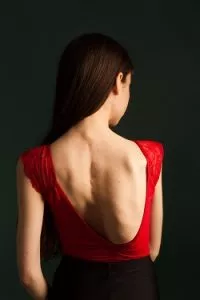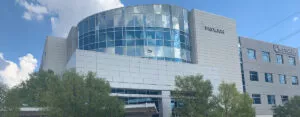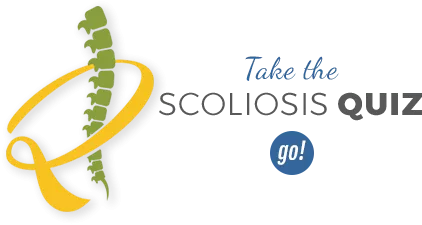
SCOLIOSIS
The pediatric orthopedic surgeons at Medical City Children’s Orthopedics & Spine Specialists offer the most advanced treatment options available. Thus, for children with painful scoliosis, this means there are many methods to successfully treat a child’s condition. To date, we have successfully performed more than 16,000 spine surgeries.
We specialize in treating scoliosis from children all the way to adults.
Scoliosis
 Scoliosis is a muscular disorder in which the spine curves to the left or right when viewed from the back — creating an S or C-shaped curve. At our practice, our physicians diagnose and treat all types of scoliosis in children. We see cases from mild to severe and offer the most advanced conservative treatment options. Most children with this condition may not need complex treatments, but they need to see a pediatric doctor for an evaluation.
Scoliosis is a muscular disorder in which the spine curves to the left or right when viewed from the back — creating an S or C-shaped curve. At our practice, our physicians diagnose and treat all types of scoliosis in children. We see cases from mild to severe and offer the most advanced conservative treatment options. Most children with this condition may not need complex treatments, but they need to see a pediatric doctor for an evaluation.
To begin with, our treatment starts with a comprehensive evaluation and diagnosis of a child. Together, we will discuss options with honesty and compassion. We partner with parents every step of the way. Thus, we can develop a personalized treatment plan for your child that makes you feel comfortable and confident in your decision.
In many cases, our team of specialists will follow up with you and your child in four to six months. Then, we will monitor your child’s progress into adulthood when the disease can become more severe. Or determine that your child’s risk is so low that your child’s condition will not progress.
While growing up, Joy suffered from severe scoliosis which hindered her from joining in on the activities she loved. Because of her scoliosis, Joy’s mother brought her to Dr. Shyam Kishan for an evaluation. By collaborating with Joy and her family, Dr. Kishan created a treatment plan and explained everything every step of the way. After her successful surgery, Joy is so happy and has resumed all the activities she loves, like archery, equestrian riding, and biking to name a few.
The Main Types of Scoliosis are:
- Idiopathic scoliosis. 80 percent of these cases are idiopathic, making it the most common type. Idiopathic means that doctors can’t pinpoint the cause of the spinal curvature. It is further classified by the age of the patient.
- Infantile scoliosis, also known as early-onset, develops in children, mostly boys, under age 3.
- Juvenile scoliosis, more common in girls, occurs between the ages of 3 and 10.
- Adolescent scoliosis makes up the majority of idiopathic cases. It’s most common in girls between the ages of 11 and 17.
- Congenital scoliosis is present at birth and happens when the vertebrae fail to develop properly in utero. This type is rare and is often seen with other health issues related to the heart, kidney, or bladder.
- In neuromuscular-related scoliosis, the curve in the spine is caused by a neuromuscular condition such as spina bifida, muscular dystrophy, or cerebral palsy.
Symptoms
For children with scoliosis, they may experience lower back pain or discomfort but most commonly, the symptoms are seen in their physical appearance. They include:
- Shoulders appear uneven
- One hip is higher than the other
- Waist looks uneven
- The rib cage is more prominent on one side
- Pelvis is tilted
Diagnosis
At Medical City Children’s Orthopedics & Spine Specialists, our board-certified pediatric orthopedic physicians perform a comprehensive evaluation. Then with the diagnosis for your child’s condition they create a personalized treatment plan. As an example, our evaluation may include:
- A medical history
- A physical exam
- An X-ray and/or CT scan
 At the Southwest Scoliosis Institute, we are recognized as leaders in Scoliosis diagnosis, treatment and care. However, we are also involved in Scoliosis Research. Our research includes causes related to genetic possibilities, diagnostics, and increased successful surgical outcomes. Please take time to look at our Southwest Scoliosis and Spine Institute website to get more in-depth information regarding the different types of scoliosis and the various treatments available.
At the Southwest Scoliosis Institute, we are recognized as leaders in Scoliosis diagnosis, treatment and care. However, we are also involved in Scoliosis Research. Our research includes causes related to genetic possibilities, diagnostics, and increased successful surgical outcomes. Please take time to look at our Southwest Scoliosis and Spine Institute website to get more in-depth information regarding the different types of scoliosis and the various treatments available.
Treatment for Scoliosis
After we complete a thorough evaluation, our team will develop a treatment plan tailored to your child’s specific condition. Based on several factors, age, location, and type of curve, different treatment options will be offered. Additionally, if there are other health issues or concerns we will discuss those, but we consider surgery only when needed.
Meanwhile, our surgeons use the most advanced treatments. Because we want to ensure that our patients return to playing sports, and other activities, as soon as possible. In recent years, the medical profession has made great advances in the diagnosis and treatment of scoliosis. Due to enhanced recovery techniques after spine, pelvic, and hip procedures, our patient’s hospital stays are shorter than most.
After we complete a thorough evaluation, our team will develop a treatment plan tailored to your child’s specific condition. Based on several factors, age, location, and type of curve, different treatment options will be offered. Additionally, if there are other health issues or concerns we will discuss those, but we consider surgery only when needed.
Meanwhile, our surgeons use the most advanced treatments. Because we want to ensure that our patients return to playing sports, and other activities, as soon as possible. In recent years, the medical profession has made great advances in the diagnosis and treatment of scoliosis. Due to enhanced recovery techniques after spine, pelvic, and hip procedures, our patient’s hospital stays are shorter than most.
Observation
In addition, many of our patients do not require surgery to correct their condition. However, children often need to be observed closely before and during their adolescent growth spurts. In the event, that curves may be progressing rapidly. And it will also identify those that remain stable over time.
Bracing
For spine curves in children that have grown, we commonly recommend bracing. In many cases, a brace can reduce the chance of a childhood curvature progressing. In fact, sometimes a brace will reduce the chance of requiring surgery.
Spinal Rehab
To date, physical therapy has not been shown to alter the rate of curvature progression in pediatric patients. On the other hand, strengthening and conditioning exercise programs often help improve back pain. Because strengthening the muscles that support the spine sometimes helps alleviate the pain.
Surgical Options
More often than not, patients will wear a brace to treat scoliosis. But in some cases where patients experience an increase in curvature and are in pain, surgery may be needed. Scoliosis surgeries are complex with multi-step procedures. For this reason, should your child need surgery, our highly skilled surgeons are here to help. They will provide the expert care and attention your child deserves.
While spine surgery can improve your child’s condition, we know that it produces stress on both the child and the family. Under these circumstances, we make every effort to provide you and your family with the resources and education needed. Thus, we will help you prepare for and know what to expect during the surgery. Finally, we will make you our top priority to help make sure you are ready for surgery.
The Tether Procedure
The tether procedure for children and adolescents with scoliosis is a type of spinal implant used to correct scoliosis. The correct name for the procedure is vertebral body tethering (VBT). VBT is a minimally invasive surgical technique used to correct scoliosis, which is a condition where the spine curves sideways.
During a VBT procedure, a flexible cord, or “tether,” is attached to the curved part of the spine and anchored to the vertebrae on either side of the curve. The tether is then tightened to gradually straighten the spine over time. The tether is made of a strong, biocompatible material and is designed to remain in the body permanently.
VBT with a tether is a newer alternative to traditional scoliosis surgery, which involves spinal fusion. Unlike fusion, VBT allows for continued motion in the spine and does not require the use of bone grafts or hardware such as screws and rods. However, not all patients with scoliosis are candidates for VBT, and the procedure is not widely available in all regions. It is important to consult with a qualified medical professional to determine the best treatment option for your individual case.
Contact Us to Schedule an Appointment
We consider the future growth of each patient as an important component of the treatment plan. Our approach helps children experience the least disruption to their daily routine. As doctors, we understand that children need sports, games, and fun things. So, please get in touch with us today to learn more about your child’s scoliosis and to know the treatment options that will improve the child’s quality of life.
With today’s technology and medical advancements, treating your child with Pediatric scoliosis can lead to a very successful life for the child. Fortunately, new treatments can help to manage and correct the curve in the spine. Through your support, coupled with the dedication of our scoliosis experts and specialists, we will help your child get on the road to leading a happy life.
Finally, the pediatric scoliosis treatment team at the Southwest Scoliosis and Spine Institute with offices in Arlington, Dallas, Flower Mound, Frisco, and McKinney, TX is available to ensure your child’s continued health. Our doctors stand ready to speak with you about the many ways to treat scoliosis in children. So, call us today at (469) 202-4490 to schedule an appointment.
____________________
Footnote:
Southwest Scoliosis Institute: Scoliosis
Call 214-556-0590 to make an appointment.
Expert health care for children from birth through adolescence at five
convenient locations: Arlington, Dallas, Flower Mound, Frisco, and McKinney, TX

